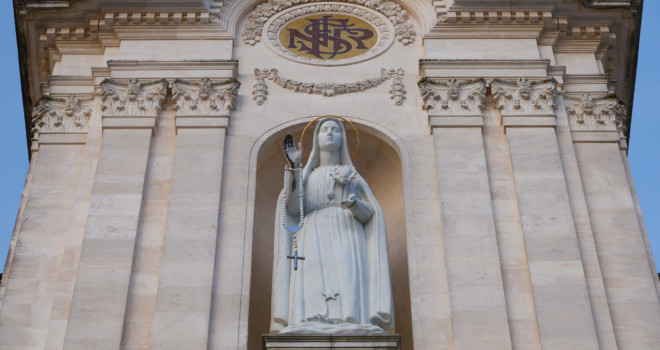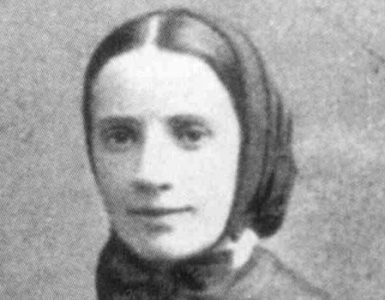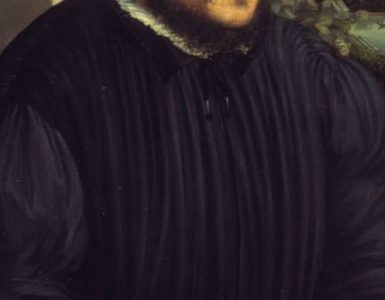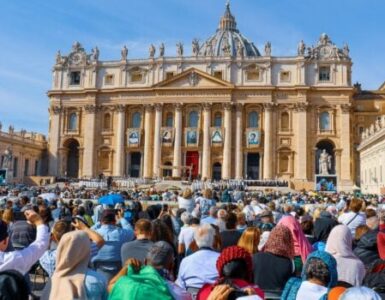Part 1: The Immaculate Heart for the World
Corona teaches us how suddenly everything can change, that we are questioning today what yesterday we considered undoubtedly true. But whatever unforeseeable things may come, whatever trials still await us – in so many people, the virus has also awakened an appreciation for the essentials of life and brought to light what things are really worth, for better or worse.
On the bell tower of Fatima, an impressive statue speaks of the Immaculate Heart of Mary since 1958. Especially today, her Immaculate Heart is our refuge and the way that leads us to God. Isn’t it moving that in these very times Francisco and Jacinta Marto, the holy shepherd children, died of another virus, the Spanish Flu, as Our Lady predicted? In a unique way, Lúcia dos Santos, the surviving visionary, shaped the design of this piece of art, executed by a priest who was a Dominican monk. In this statue, we see how Lúcia herself saw Our Lady at Fatima.
With this short article, we begin to retell the story of this very special statue of Fatima in five episodes. For many people, it is a little-known avenue to understanding the events at Fatima. The shepherd girl Lucía dos Santos (1907-2005) encouraged the artist monk to write about their cooperation. “In your writing,” she said, “please stress the spiritual meaning of things, in order to raise minds, which today have become so materialistic, to regions of the supernatural; so that they may understand the true meaning and purpose of the coming of Our Lady to earth, which is to bring souls to heaven, to draw them to God.” (Fr. Thomas McGlynn O.P., Vision of Fatima)
Fatima’s Bell Tower
The white bell tower with its golden crown shining from afar has long been a symbol of Fatima. As if with arms spread wide open, magnificent colonnades with altars devoted to the stations of the Way of Cross open from it to the Cova da Iria to receive pilgrims from all over the world. From May 13 to October 13, Our Lady of the Rosary appeared there to three shepherd children. The two youngest, Jacinta (1910-1920) and Francisco Marto (1908-1919), were canonized by Pope Francis in Fatima on May 13, 2017.
“Pray the Rosary every day, in order to obtain peace for world, and the end of the war,” Mary asked the three shepherd children. “Then she began to rise serenely, going up towards the east, until she disappeared in the immensity of space,” describes Lúcia, the oldest of them, the end of the first apparition on May 13th. “The light that surrounded her seemed to open up a path before her in the firmament.” Before this, Our Lady had opened her hands, communicating to them a light so intense that, as it streamed from her hands, its rays penetrated their hearts and the innermost depths of theirs souls, making them see themselves in God and repeating in their hearts: “O most Holy Trinity, I adore you! My God, my God, I love You in the most Blessed Sacrament.”*
Mysteries of the Rosary
The Basilica of the Santuario de Fátima illustrates all the mysteries of the Holy Rosary to pilgrims through the golden shimmering reliefs of its two times seven side altars and the impressive apse relief of bright white stucco above the main altar. On the feast of the Rosary of the Marian Year 1954, the great pilgrimage church of Fatima was consecrated as the Basilica of the Rosary, after its foundation stone had already been laid on May 13, 1928 in the presence of the Portuguese President and Prime Minister and some 300,000 pilgrims.
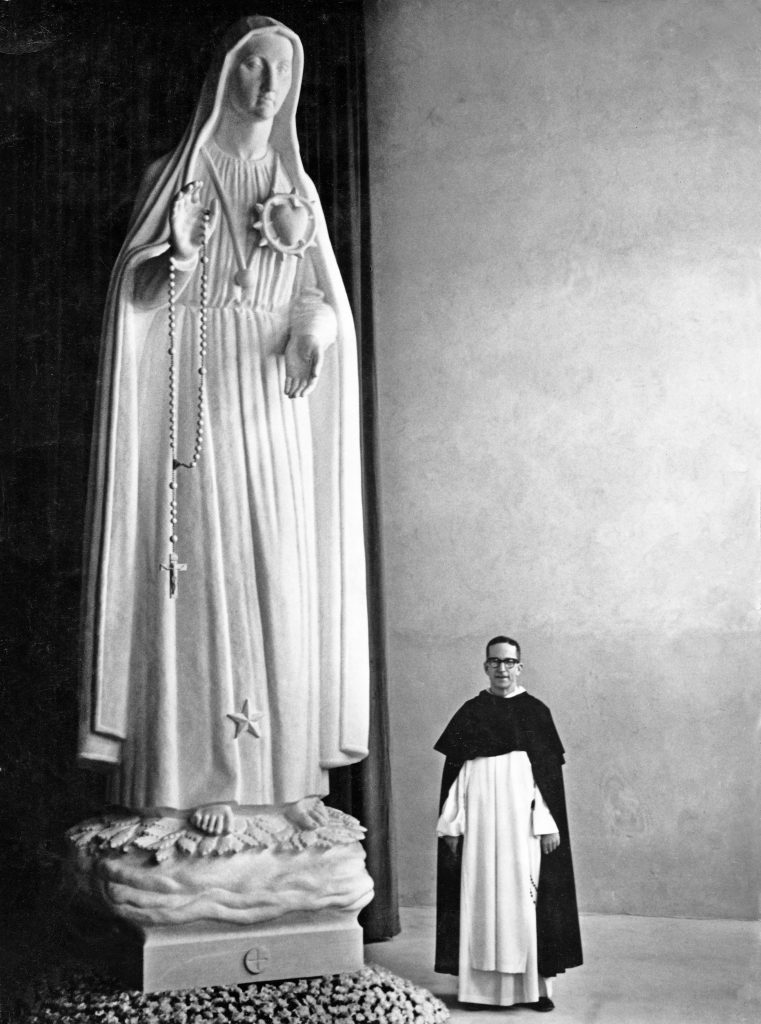
The last of the mysteries of the Rosary, the Coronation of Mary in Heaven, is powerfully symbolized by the golden crowned tower of the Basilica and makes it triumph. Above the main portal, it shows the Coronation of Mary as a precious mosaic of the Vatican workshops, which the Fatima Pope, Pius XII (1876-1958) had ordered blessed. And through all the hours of the day, the tower, with the ringing of its bells, sings the Fatima Ave: “With sweet Mother’s pleading / She asked us to pray. / Do penance, be modest, The Rosary each day.”
Since May 13, 1958, the crowned bell tower has been decorated with the gift of the American Catholics to Fatima placed in a large niche, an impressive statue of the Immaculate Heart of Mary, more than five meters high, created by the Dominican priestly monk and sculptor Father Thomas McGlynn, O.P. (1906–1977). It dominates the panorama of the Santuario de Fatima.
The Statue of July 13, 1917
Even superficial observers immediately recognize it as a statue of Fatima. A closer look, however, makes one pay attention. This picture of Our Lady, who said of herself: “I am from Heaven”, has a special character. Those who become familiar with it through repeated contemplation may find it more deeply moving than the world-famous statue at the apparition site itself, and even more so than the touching sculpture on the willow called Valinhos, which recalls Mary’s apparition on August 19 and her wish: “Pray, pray very much, and make sacrifices for sinners; for many souls go to hell, because there are none to sacrifice themselves and pray for them.”
The American statue on the bell tower commemorates the apparitions of Our Lady on June 13, 1917, when she first revealed her Immaculate Heart. For many faithful, this message is particularly moving. When Lucia asks whether she will be taken to heaven, Mary says that she will soon take Jacinta and Francisco, which touches us in these Corona days. But Jesus wishes to make use of Lucía, “to make me known and loved. He wants to establish in the world devotion to my Immaculate Heart.” I promise salvation to those who embrace it, and these souls will be loved by God, like flowers placed by me to adorn His throne.” When Lucia becomes sad, Mary consoles her: “Are you suffering a great deal? Don’t lose heart. I will never forsake you. My Immaculate Heart will be your refuge and the way that will lead you to God.”
A Heart Encircled by Thorns
“As Our Lady spoke these last words,“ Lúcia recalls, “she opened her hands and for the second time, she communicated to us the rays of that same immense light. We saw ourselves in this light, as it were, immersed in God. Jacinta and Francisco seemed to be in that part of the light, which rose to heaven, and I in that part which was poured out on the earth. In front of the palm of Our Lady’s right hand was a heart encircled by thorns, which pierced it. We understood that this was the Immaculate Heart of Mary, outraged by the sins of humanity, and seeking reparation.”
After 103 years of Mary’s pain and her warning about hell, we cannot consider sin to be only an evil act in the knowledge of the wickedness of such actions. This is evil enough, but acts of state legislation of our time all around the globe also remind us of the first sin. For Thomas Aquinas, it consists in the will to determine for oneself what good and evil deeds are, in this sense to desire similarity with God, in the knowledge of good and evil, that is, to foresee from oneself what good and evil will fall to man. Is this the very essence of liberalism, the abuse of freedom par excellence, offence against the “ecology of man”, of which Pope Benedict XVI has frequently warned secular society, for example in the German Parliament?
It is the Immaculate Heart of Mary, wounded by the sins of humanity, which is represented by the American statue on the bell tower of Fatima. As a glance from the side shows, Mary leans out of the niche, turned towards the shepherd children, but also towards us, the faithful. Her hands open up, as described by Lucía.
Participating Co-Redemptrix
While her left hand indicates a lifting, encouraging gesture, her right hand, from which her long rosary hangs freely, seems to offer a motherly even comforting, blessing. Mary’s delicate face is framed by a veil that completely covers her hair and merges into the folds of a cloak. From it speaks a touching seriousness. Behind her head, a narrow gold ring marks a halo. The hem of her simple robe is decorated with a five-pointed star, on which the shadow of the cross on her white rosary falls in the late afternoon sun.
From the neck down over the folds of her tunic hangs a small globe on a ribbon just above the waist. In front of the left side of her chest, Mary shows her Immaculate Heart, encircled by a crown of thorns. Is it the painful, shameful, and yet glorious crown of her Son, in which Mary participates through her coronation, which we contemplate in the last mystery of the Rosary and which the Tower of Fatima proclaims? Under Jesus’ cross, suffering unspeakably, Mary’s heart was pierced by a sword, “that the thoughts of many hearts may be revealed,” as the aged Simeon had foretold her in the temple. Does Mary’s heart, surrounded by thorns, point to the mystery of her being the “participating Co-Redemptrix”?
The niche is framed by classicist pilasters, vaulted with a curved cornice under which letters of her title Nossa Senhora de Fátima ornamentally entwine as a golden mosaic medallion.
A Monk Remembers
Since 2017, the long forgotten memoirs of Father McGynn are again available on the book market, in which he described the creation of that statue 70 years before. The reader is amazed to learn that he actually sees at the bell tower the statue of the shepherd girl, who saw Our Lady and spoke with her. During a co-production that is probably unique in art history, the priestly monk, who created his first sculpture at the age of four, became a tool in the hand of Irmã Dores from February 8 to 14, 1947. This was the Lucía’s religious name in the house of the Dorothean Sisters in Vila Nova de Gaia on the southern bank of the Douro River opposite Porto.
“The composition was not mine at all,” he writes himself. “It was in every respect that of Irmã Dores. The execution alone, and that under all of the specifications and corrections given by Irmã Dores, could be considered proper to my own efforts. I shall always think of this as ‘our statue’. The success that it has cannot be explained by artistic skill of mine, but rather must be accounted to the spiritual skill of the little child, who saw Our Lady at Fatima.” For this reason, Lúcia’s statue itself, the conversations of the artist monk with the shepherd girl and his encounters with witnesses of the apparitions and miracles become an authentic source deepening our understanding of Fatima.
Who was Fr. McGlynn O.P.?
On the recommendation of Francis Cardinal Spellman (1889-1967), the Archbishop of New York, Fr. McGlynn—sonof the lawyer and successful stage and film actor Frank McGlynn (1866-1951)–traveled to Portugal in 1947 to present his sculpture model to Lúcia. His client, the Daprato Statuary Company in Chicago, which had been awarded by Saint Pius X the title Pontifical Institute of Christian Art in 1909, was highly satisfied with the work of the famous sculptor, whose Roman studio had already been honored by Cardinal Secretary of State Eugenio Pacelli (1876-1958), the later Pope Pius XII, with a visit in 1935. The approval for an enlarged version in noble materials was on hand. The statue was to be the first in a series that McGlynn had promised to design. But he wanted to be sure that his model fitted Lúcia’s descriptions and that she agreed with his design and symbolism.
McGlynn entered the Dominican Order at the age of 19 and was ordained a priest in 1932. For 45 years of his priesthood, he saw himself primarily as a priest and pastor, especially in impoverished neighbourhoods. In 1934, McGlynn graduated in sculpture from the British Royal Academy of Fine Arts in Rome. This was followed by studies at the Cranbrook Academy of Art near Detroit. His most important teacher became Carl Milles (1875-1955), one of the most influential Swedish sculptors, who worked there from 1932 to 1951 after years at the Stockholm School of Art.
In addition to works of religious art, he created busts of Popes Pius XII, John XXIII, and Paul VI. McGlynn also used his artistic skills to design prostheses for the disabled. In 1944, his play Caukey was published, which premiered on Broadway and received good reviews. It takes a critical look at the situation of poor, educationally disadvantaged African-Americans and seems to be quite topical even today.
Departure to Vila Nova de Gaia
The Dominican friar traveled by plane with the shapeless box that protected his model, which attracted attention, so he had to tell everyone about the purpose of his trip and the apparitions of Fatima, whose credibility was confirmed in 1930 after a seven-year ecclesiastical trial. Fatima must be known throughout the world, he tells the surprised passengers and crew members above the clouds. This is the reason why he travels to Portugal with such strange luggage. “So Lucia is still alive and is only forty years old?” were the surprised inquiries.
Four years after the apparitions, Lucia was entrusted, on the advice of the Bishop of Leiria, to a home for children of the Dorothean Sisters to protect them from the onslaught of visitors. She was named Maria das Dores and no one, not even her friends, knew of her connection to Fatima. With the religious name Irmã Dores, Sister of Mary’s Sorrows, she joined the Congregatio Sororum a Sancta Dorothea SSD in the Spanish border town of Tui in 1925, which is dedicated to the poorest children and young people. She returned to Portugal only in 1946.
On the silver anniversary of the apparitions in 1942, Irmã Dores‘ writings were published. Some of these writings date from 1927; she recorded most of them, however, in obedience to the bishop from 1935.
✠
Editor’s note: Translation and editorial assistance was kindly provided by Jane Stannus, a journalist and translator. She is a regular contributor to The Spectator USA. Her work has also appeared in Crisis Magazine, the Catholic Herald, Critic Magazine and the National Catholic Reporter.
This article is the first part in a weekly series on Fr. McGlynn and the work of Our Lady of Fatima. Check back each Friday for
Sources and quotations for this include the book by Sr. Lucía dos Santos, Fatima in Lucia’s own Words. As well, quotations and the story of Fr. McGlynn can be found in the book, Vision of Fatima, which is available through Sophia Institute Press.
featured image: The Fatima Statue by Fr Thomas McGlynn OP, photo by Fr. Lawrence Lew, OP / Flickr (CC BY-NC-ND 2.0)


